Java:「Executors」与「Thread Group」
最近在做和「异步」相关的开发,有机会对「Executors」这一套设计做了更细致的学习,在这里记录一下。
下面这段代码使用「ExecutorService」执行一个任务:
import java.util.concurrent.ExecutorService;
import java.util.concurrent.Executors;
public class ExecutorsDemo {
public static void main(String[] args) {
ExecutorService executorService = Executors.newSingleThreadExecutor();
executorService.submit(() -> {
try {
Thread.currentThread().wait();
} catch (InterruptedException e) {
e.printStackTrace();
}
});
// main thread会在这里block住。
}
}
如上所示,这个任务永远不会结束:
Thread.currentThread().wait();
虽然我们使用的是「SingleThreadExecutor」,但它也会开启一个新的Thread执行任务。但是如果跑上面的代码,我们会发现main thread会被这个task给block住。下面是代码执行的截图:
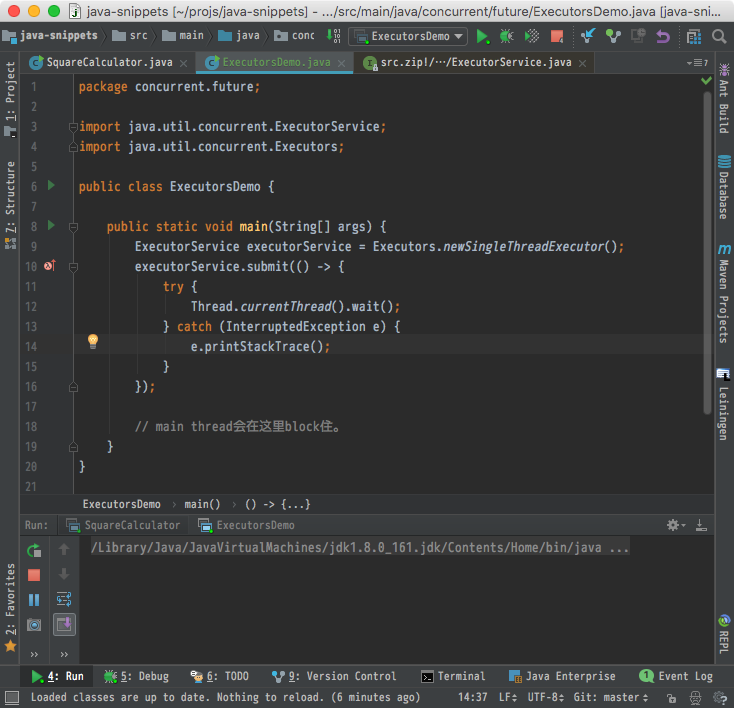
可以看到main thread永不退出,被executor service里面的task给block住了。除非我们加入代码,让executor service进行shutdown,main thread才会退出:
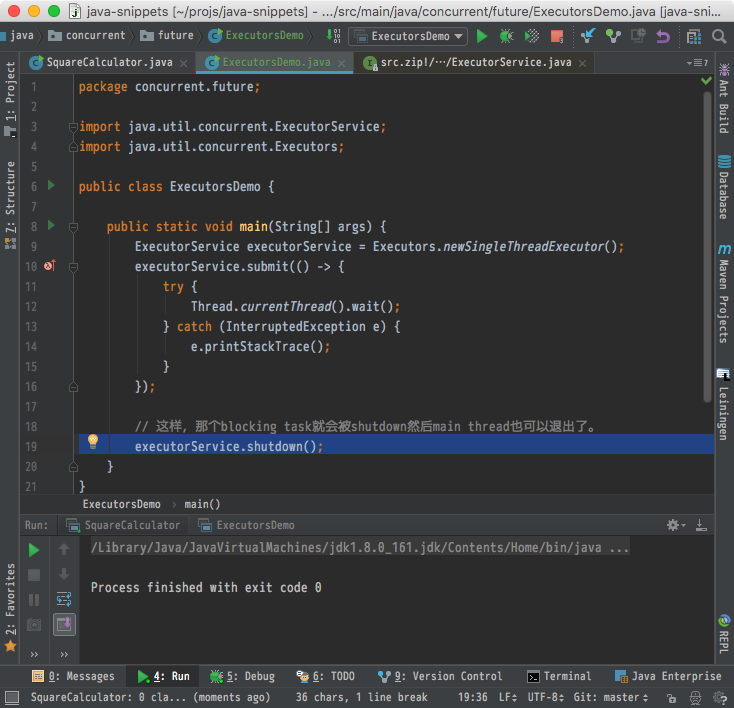
如上所示,使用「shutdown()」方法,这个任务就退出了,于是main thread也跟着退出。
我想知道上面这个场景是如何实现的,就跟踪了一下Executors的代码。首先,ExecutorService的submit方法是这样的:
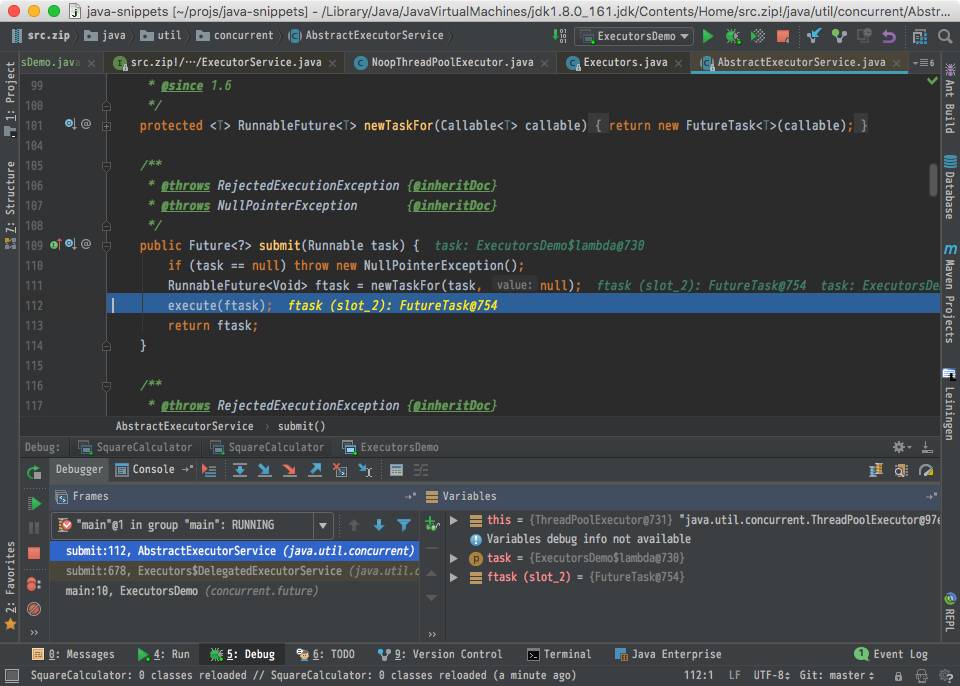
是在AbstractExecutorService里面实现的,这个submit方法里面的重点是上面这个execute方法。
跟踪进execute方法,重点是这个addWorker方法:
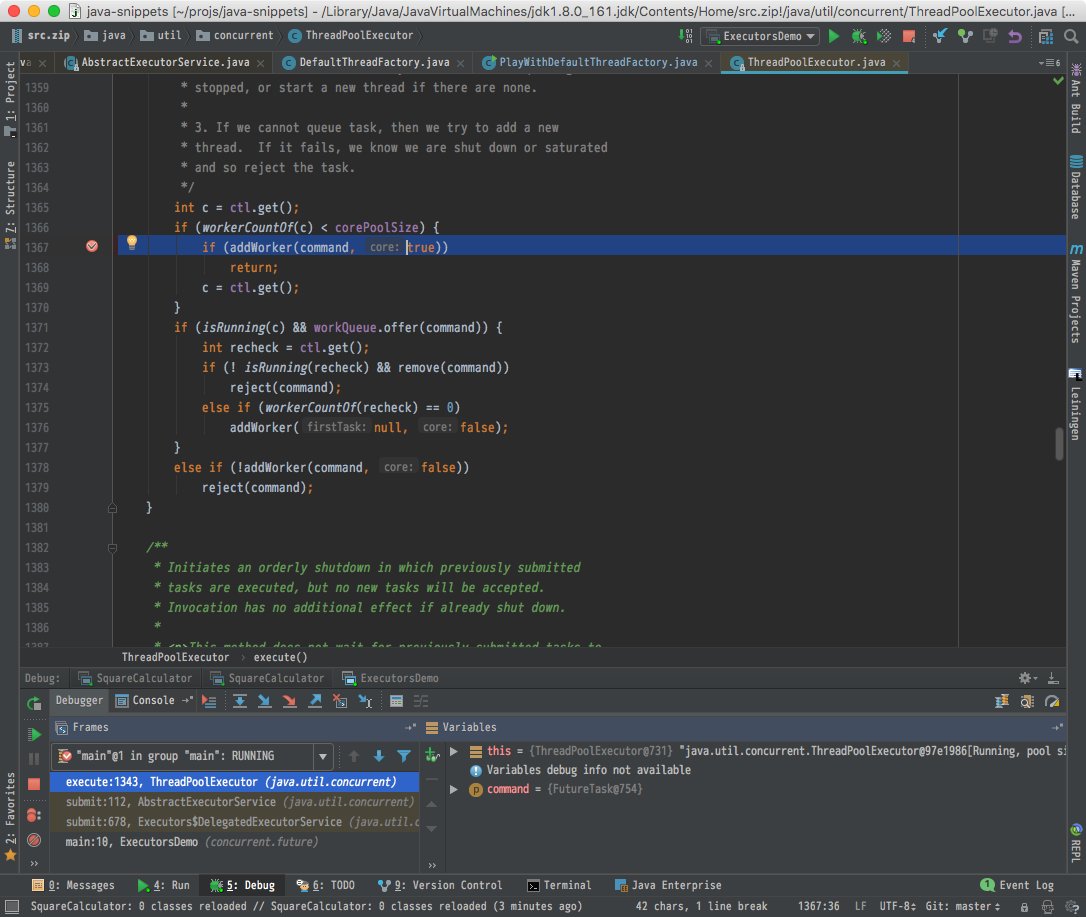
再进入addWorker方法查看,重点是这里:
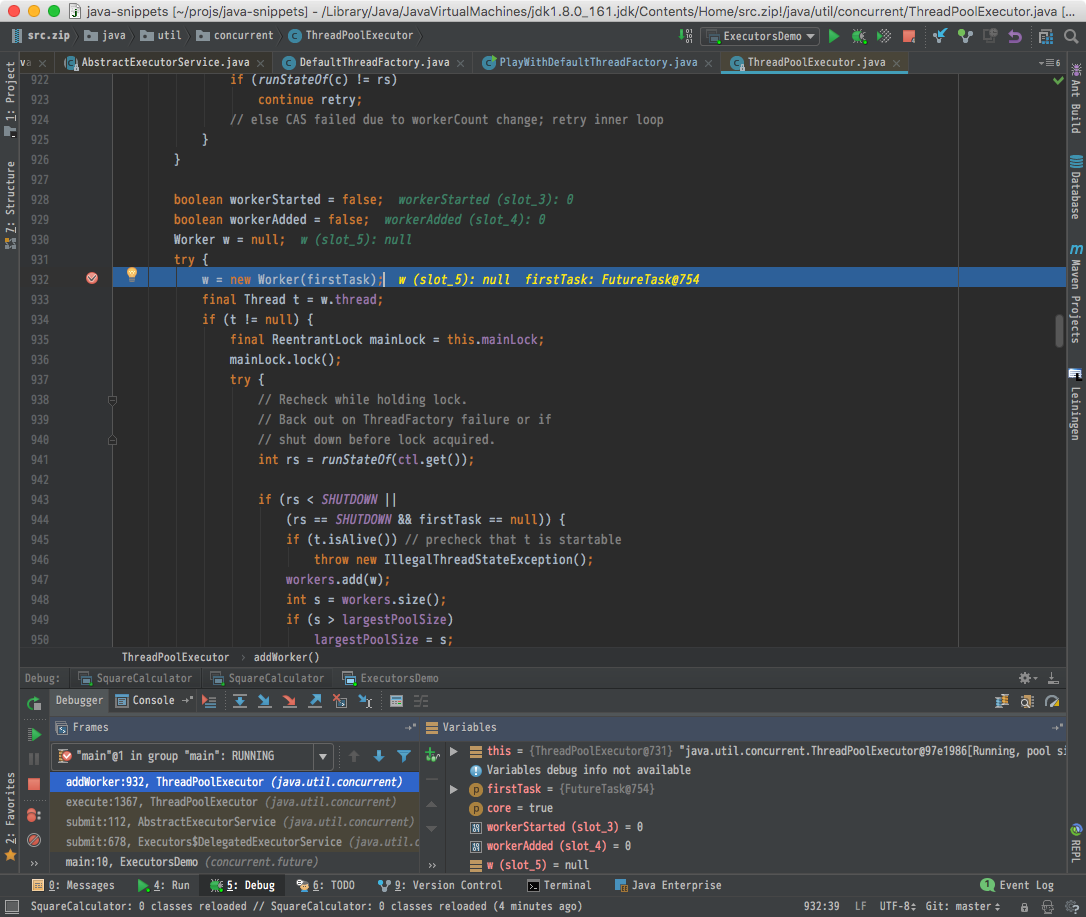
可以看到创建了一个Worker的实例。创建完worker以后,就会在addWorker方法里面启动它:

如上所示,这个t就是一个Thread实例,封装在worker里面。Worker这个class在ThreadPoolExecutor内部,代码如下:
/**
* Class Worker mainly maintains interrupt control state for
* threads running tasks, along with other minor bookkeeping.
* This class opportunistically extends AbstractQueuedSynchronizer
* to simplify acquiring and releasing a lock surrounding each
* task execution. This protects against interrupts that are
* intended to wake up a worker thread waiting for a task from
* instead interrupting a task being run. We implement a simple
* non-reentrant mutual exclusion lock rather than use
* ReentrantLock because we do not want worker tasks to be able to
* reacquire the lock when they invoke pool control methods like
* setCorePoolSize. Additionally, to suppress interrupts until
* the thread actually starts running tasks, we initialize lock
* state to a negative value, and clear it upon start (in
* runWorker).
*/
private final class Worker
extends AbstractQueuedSynchronizer
implements Runnable
{
/**
* This class will never be serialized, but we provide a
* serialVersionUID to suppress a javac warning.
*/
private static final long serialVersionUID = 6138294804551838833L;
/** Thread this worker is running in. Null if factory fails. */
final Thread thread;
/** Initial task to run. Possibly null. */
Runnable firstTask;
/** Per-thread task counter */
volatile long completedTasks;
/**
* Creates with given first task and thread from ThreadFactory.
* @param firstTask the first task (null if none)
*/
Worker(Runnable firstTask) {
setState(-1); // inhibit interrupts until runWorker
this.firstTask = firstTask;
this.thread = getThreadFactory().newThread(this);
}
/** Delegates main run loop to outer runWorker */
public void run() {
runWorker(this);
}
// Lock methods
//
// The value 0 represents the unlocked state.
// The value 1 represents the locked state.
protected boolean isHeldExclusively() {
return getState() != 0;
}
protected boolean tryAcquire(int unused) {
if (compareAndSetState(0, 1)) {
setExclusiveOwnerThread(Thread.currentThread());
return true;
}
return false;
}
protected boolean tryRelease(int unused) {
setExclusiveOwnerThread(null);
setState(0);
return true;
}
public void lock() { acquire(1); }
public boolean tryLock() { return tryAcquire(1); }
public void unlock() { release(1); }
public boolean isLocked() { return isHeldExclusively(); }
void interruptIfStarted() {
Thread t;
if (getState() >= 0 && (t = thread) != null && !t.isInterrupted()) {
try {
t.interrupt();
} catch (SecurityException ignore) {
}
}
}
}
可以看到它包含task和运行task所需的thread,并且它实现了Runnable接口。注意它的run方法:
/** Delegates main run loop to outer runWorker */
public void run() {
runWorker(this);
}
也就是说,「runWorker」方法是worker的执行逻辑,而「runWorker」方法里面值得一看的是这里:
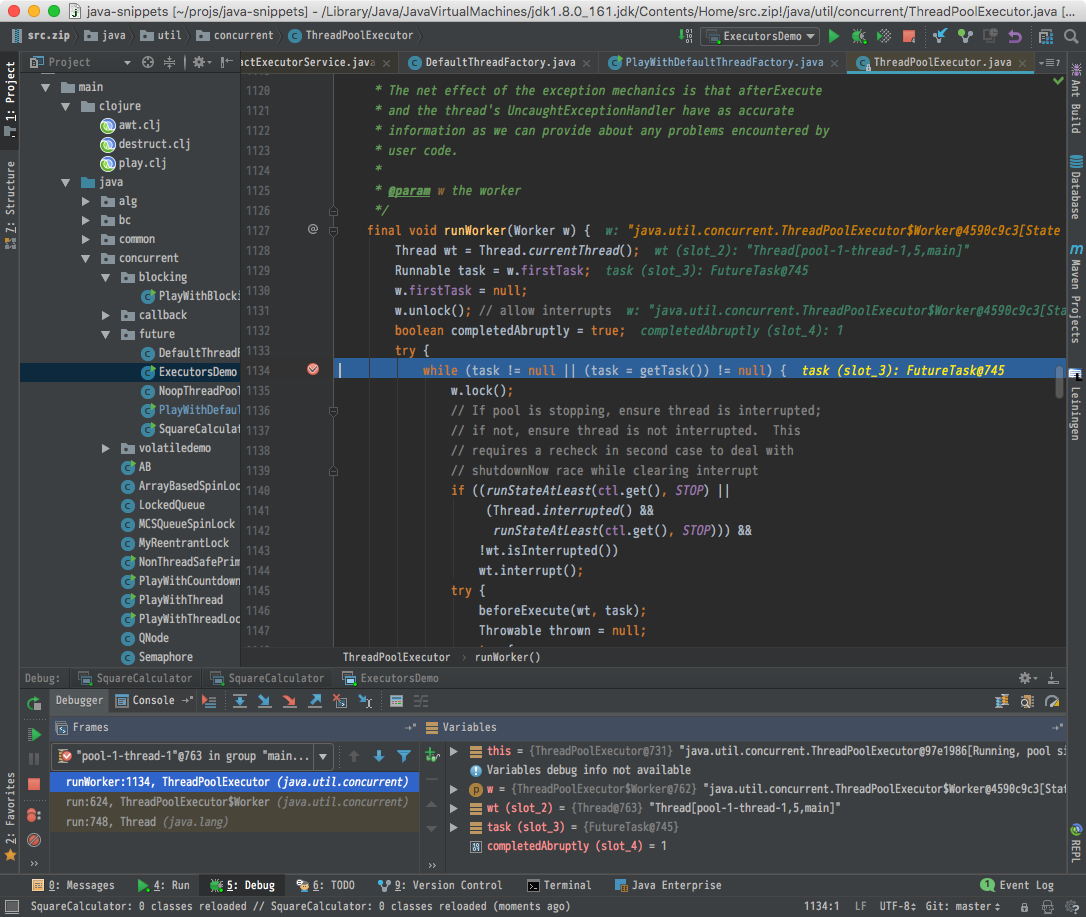
这个「getTask()」有一处代码是可能block住当前thread的:
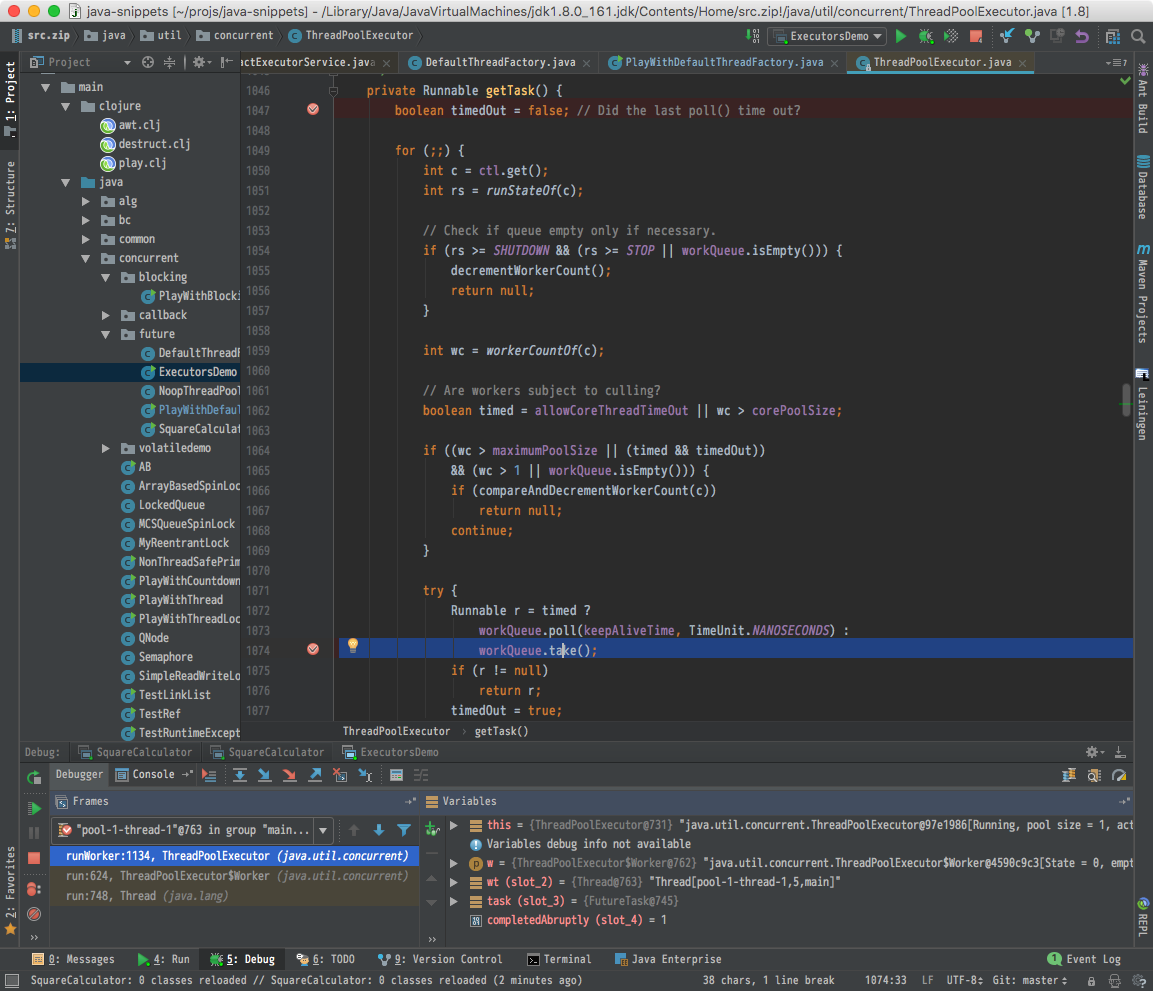
这个workQueue是BlockingQueue类型,它的「take()」方法会hold住当前thread。
但是,这个worker thread是怎样block住main thread的呢?这个要从ExecutorService的创建里面找答案:
ExecutorService executorService = Executors.newSingleThreadExecutor();
下面是「Executors.newSingleThreadExecutor()」的代码:
public static ExecutorService newSingleThreadExecutor() {
return new FinalizableDelegatedExecutorService
(new ThreadPoolExecutor(1, 1,
0L, TimeUnit.MILLISECONDS,
new LinkedBlockingQueue<Runnable>()));
}
注意创建的是ThreadPoolExecutor,跟踪进它的constructor:
public ThreadPoolExecutor(int corePoolSize,
int maximumPoolSize,
long keepAliveTime,
TimeUnit unit,
BlockingQueue<Runnable> workQueue) {
this(corePoolSize, maximumPoolSize, keepAliveTime, unit, workQueue,
Executors.defaultThreadFactory(), defaultHandler);
}
看到这里:
Executors.defaultThreadFactory(),
查看这个DefaultThreadFactory,位于Executors内部:
/**
* The default thread factory
*/
static class DefaultThreadFactory implements ThreadFactory {
private static final AtomicInteger poolNumber = new AtomicInteger(1);
private final ThreadGroup group;
private final AtomicInteger threadNumber = new AtomicInteger(1);
private final String namePrefix;
DefaultThreadFactory() {
SecurityManager s = System.getSecurityManager();
group = (s != null) ? s.getThreadGroup() :
Thread.currentThread().getThreadGroup();
namePrefix = "pool-" +
poolNumber.getAndIncrement() +
"-thread-";
}
public Thread newThread(Runnable r) {
Thread t = new Thread(group, r,
namePrefix + threadNumber.getAndIncrement(),
0);
if (t.isDaemon())
t.setDaemon(false);
if (t.getPriority() != Thread.NORM_PRIORITY)
t.setPriority(Thread.NORM_PRIORITY);
return t;
}
}
注意到这个ThreadGroup:
Thread.currentThread().getThreadGroup();
于是学习了ThreadGroup的概念,猜测在同一个thread group的thread会互相block住。为了验证自己的想法,写了如下代码:
public class PlayWithDefaultThreadFactory {
public static void main(String[] args) {
DefaultThreadFactory factory = new DefaultThreadFactory(); // 这个DefaultThreadFactory会把新的thread创建在main thread所属的group里。
// 同一个thread group里面的thread执行没结束的时候,main thread不会退出,会被block住。
Thread t = factory.newThread(() -> {
try {
sleep(3000);
} catch (InterruptedException e) {
e.printStackTrace();
}
});
// 这个thread跑起来以后,main thread会继续执行,直到block在结束的地方,等待t里面的sleep的3秒钟完成,除非像下面这样给interrupt()。
t.start();
}
}
执行上面的代码,发现同一个thread group里面的thread会把组内的其它thread给block住(但不影响其它thread执行到结束,只是其它thread不会退出):
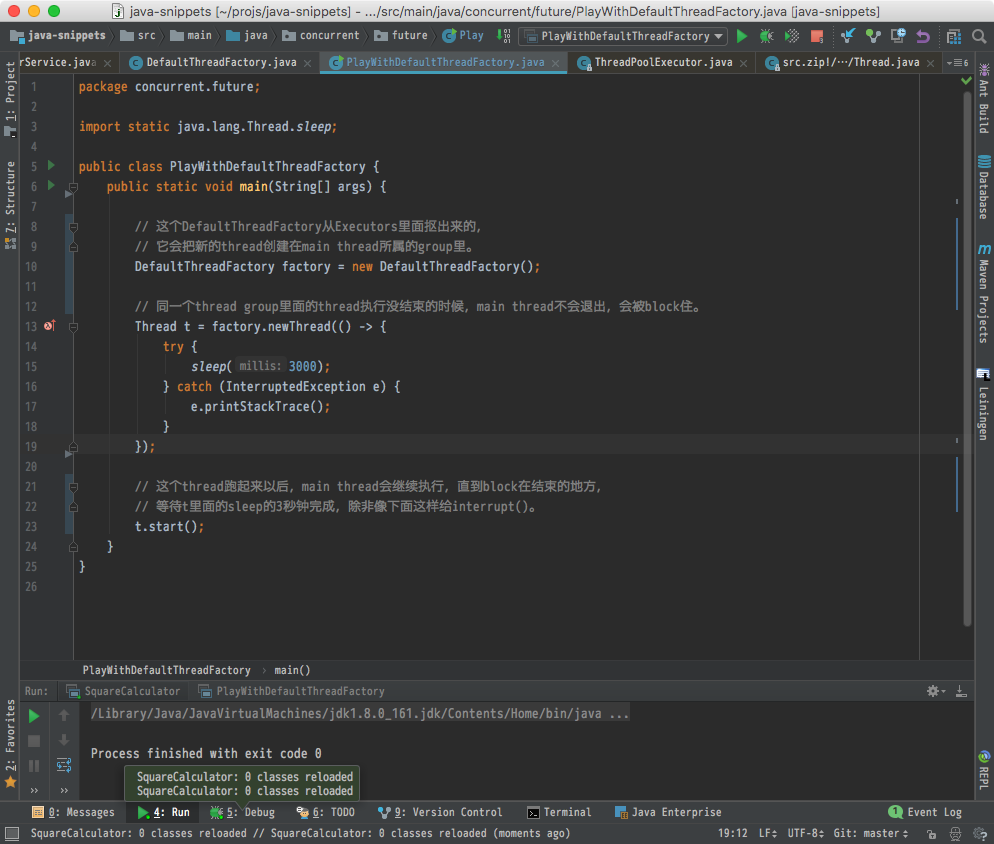
于是在上面的代码最后加上这样一行:
// 让worker thread直接退出,这样main thread就不会block在结束的位置了
t.interrupt();
执行代码,想法得到了验证:
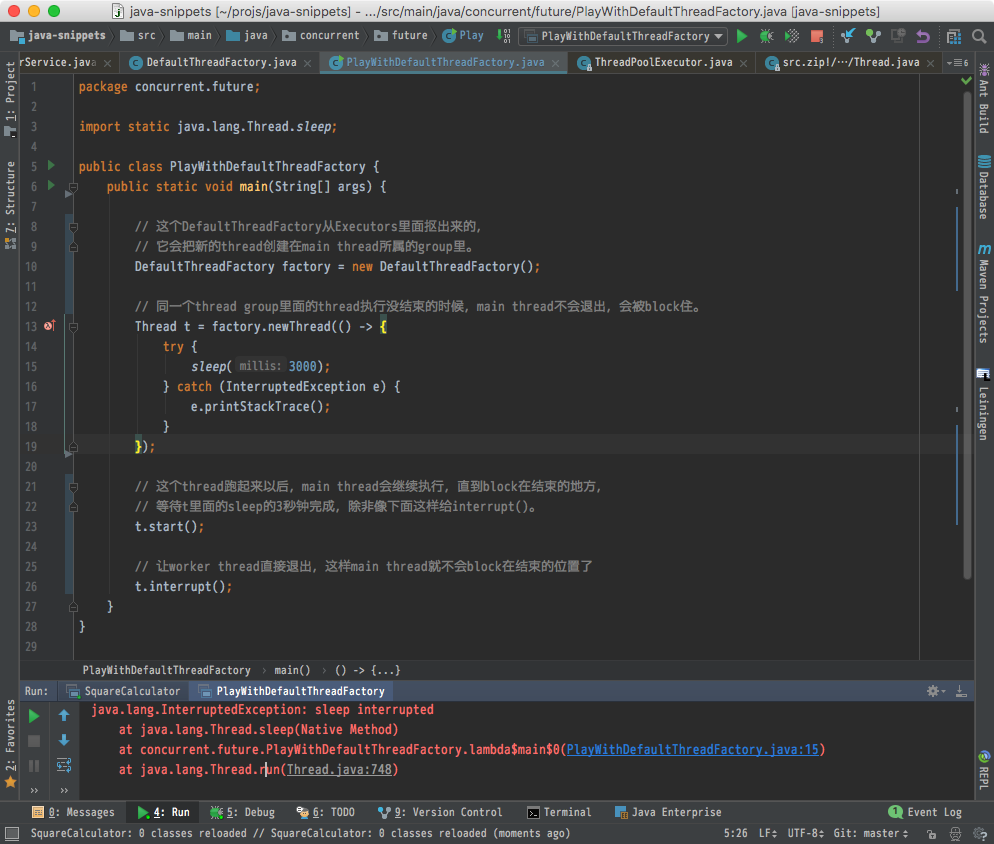
通过上面的分析,学习了thread group的概念,并且学习了Executor里面一些重要的设计思想,以及Executors内部包含的一些classes,比如DefaultThreadFactory的设计。
并发库这一块主要是Doug Lea设计并实现的,代码很值得阅读和学习。